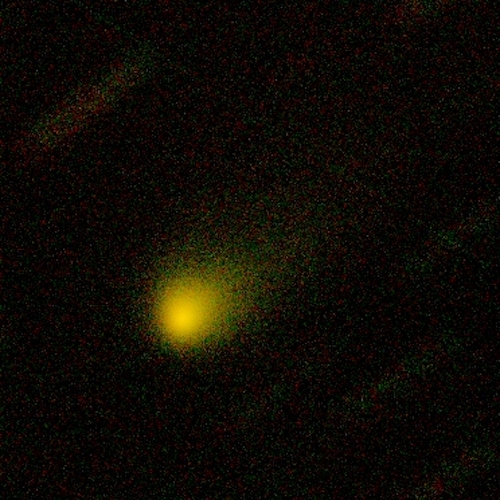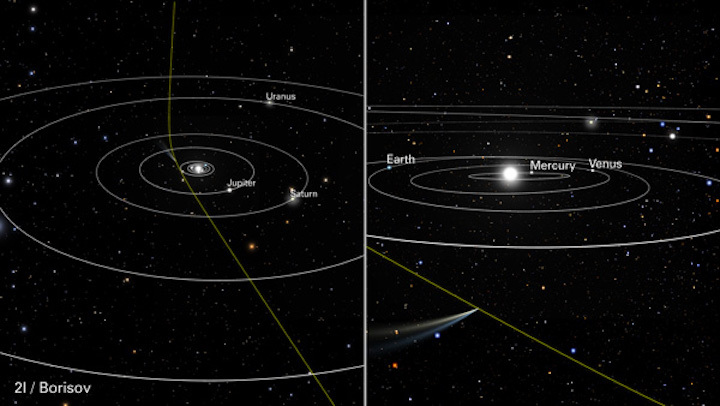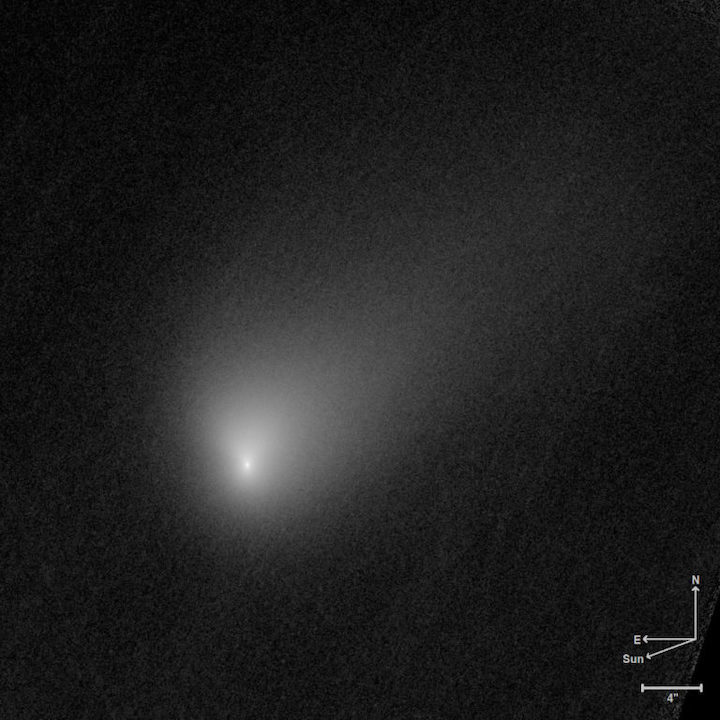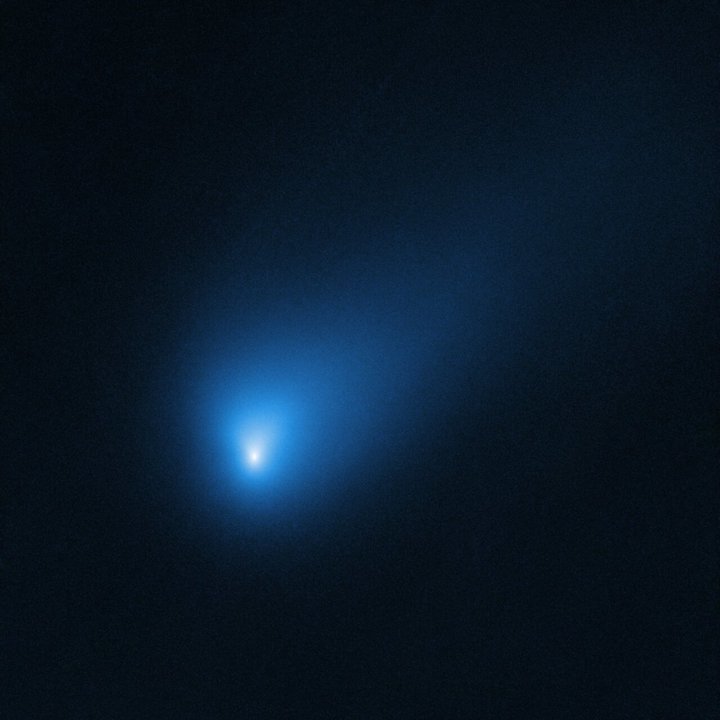17.10.2019
Ground-based observations of interstellar comet 2I/Borisov show that it looks just like comets in the solar system.

This twocolor composite image of Comet 2I/Borisov was captured by the Gemini North telescope on September 10, 2019.
Gemini Observatory / NSF / AURA
The solar system's newest interstellar visitor, Comet 2I/Borisov, looks remarkably familiar. A new study characterizing the comet revealed details, such as its nucleus size and gas distribution, that bear a striking resemblance to the icy population of the outer solar system.
At the end of August, amateur astronomer Gennady Borisov spotted an object moving through the sky. Subsequent observations revealed that the object’s speed and trajectory indicate an origin outside the solar system. Now officially known as Comet 2I/Borisov (C/2019 Q4), it is the second interstellar interloper ever identified by astronomers. The first interstellar visitor is called ‘Oumuamua (1I/2017 U1), but that one looked more like an asteroid than a comet. With its fuzz of a tail, Borisov takes a more familiar appearance.
"So far, Comet Borisov is indistinguishable from comets observed in our backyard, except for its orbit," says Michał Drahus (Jagiellonian University, Poland). "With its familiar properties, [Comet Borisov] tells us that comets similar to the ones we know from this solar system also form around other stars."
Drahus worked with Piotr Guzik, also at Jagiellonian, to observe the object in early September with the 8.2-meter Gemini North Telescope in Hawaii and the 4.2-meter William Herschel Telescope in the Canary Islands. The pair of telescopes proved ideal for studying Borisov, as they can observe at low elevations while the comet remains close to the horizon. Drahus also noted that the instruments are "extremely well managed," which enabled their technicians to rapidly respond to the unexpected observing request issued by the astronomers.
“Remarkably Similar”
For decades, astronomers have scoured the sky for comets from outside the solar system. In the violent early years of planet formation, a significant amount of material is expected to be ejected from the growing system. Most ejected material would likely start off on the outskirts of a system, in icy objects weakly held by the gravity of their star. As young planets migrate to different orbits, they would scatter this material, ejecting most of it from the system.
Yet for decades, the only comets we observed came from our own system. Then, in 2017, astronomers around the world turned their telescope towards the strange object eventually called ‘Oumuamua, a Hawaiian name meaning “messenger from afar arriving first.” Unlike Borisov, ‘Oumuamua showed no obvious signs of cometary activity. Its appearance defied expectations of what interstellar visitors should look like.
The arrival of ‘Oumuamua caused astronomers to revise their expectations of how frequently extrasolar objects should visit the solar system. Even with the updated numbers, astronomers didn’t anticipate the next visitor until after 2022. This is when the Large Synoptic Survey Telescope (LSST), a wide field-of-view telescope that will survey the whole sky every three days, is scheduled to begin science operations. Certainly, no one expected a second visitor only two years after the first.

This illustration shows the path of Comet 2I/Borisov through our solar system.
NASA
/ ESA / J. Olmsted & F. Summers (STScI)
Comet Borisov is everything that ‘Oumuamua wasn't. While the first scout seemed more like an asteroid, with little to no activity, Borisov has a fuzzy tail that marks it as cometary. Because it is active and coming closer to the Sun and to Earth, Borisov is brightening (currently at 16th magnitude) where ‘Oumuamua was dim (never brighter than about 20th magnitude). Most importantly, while ‘Oumuamua could only be studied for a handful of weeks before it became too faint to observe even with the Hubble Space Telescope, Comet Borisov will be visible to astronomers for months, allowing more in-depth observations.
Based on the new observations, Borisov's nucleus has a radius of about 1 kilometer, a common size for solar system comets. The nucleus is dominated by dust with traces of gas. The material it ejects travels at speeds similar to ejecta from solar system comets, suggesting a similar process. All in all, it "appears remarkably similar to solar system comets," Draghus says.
Future Study
Guzik's team is not the only one turning electronic eyes to the new visitor. Astronomers around the world have been observing it and will continue to do so as long as it is visible. Many of those observations have been posted on the preprint server arXiv, where Guzik's paper was originally posted in early September before its publication this week in the journal Nature Astronomy. All observations suggest that Borisov bears a striking resemblance to its solar system siblings.


The Hubble Space Telescope took this image of Comet 2I/Borisov on October 12, 2019.
NASA / ESA
"We have been happy to see subsequent submissions confirming our initial results and conclusions," Drahus says.
As Borisov moves toward its closest approach to the Sun on December 8th, and its closest approach to the Earth on December 28th, astronomers around the world — amateurs and professionals alike — will be ready. Drahus and his colleagues plan to continue monitoring the interloper to trace brightness as it receives increasing amounts of solar radiation. They also hope to continue to investigate the comet's composition.
As castoffs from other planetary systems, ‘Oumuamua, Borisov, and other interstellar scouts can reveal insights into the era of planet formation, providing context for our own solar system’s history. While ‘Oumuamua's unusual properties suggested that some young systems might be wildly different from the solar system, Borisov's similarity reassures us that other systems are more like our own.
"It seems that the population of interstellar objects is more diverse than we thought," Drahus says.
Quelle: Sky&Telescope
+++
NASA's Hubble Space Telescope has given astronomers their best look yet at an interstellar visitor — comet 2I/Borisov — whose speed and trajectory indicate it has come from beyond our solar system.
This Hubble image, taken on Oct. 12, 2019, is the sharpest view of the comet to date. Hubble reveals a central concentration of dust around the nucleus (which is too small to be seen by Hubble).
Comet 2I/Borisov is only the second such interstellar object known to have passed through the solar system. In 2017, the first identified interstellar visitor, an object officially named 'Oumuamua, swung within 24 million miles of the Sun before racing out of the solar system. "Whereas 'Oumuamua appeared to be a rock, Borisov is really active, more like a normal comet. It's a puzzle why these two are so different," said David Jewitt of the University of California, Los Angeles (UCLA), leader of the Hubble team who observed the comet.
As the second known interstellar object found to enter our solar system, the comet provides invaluable clues to the chemical composition, structure and dust characteristics of planetary building blocks presumably forged in an alien star system a long time ago and far away.
"Though another star system could be quite different from our own, the fact that the comet's properties appear to be very similar to those of the solar system's building blocks is very remarkable," said Amaya Moro-Martin of the Space Telescope Science Institute in Baltimore.
Hubble photographed the comet at a distance of 260 million miles from Earth. The comet is falling past the Sun and will make its closest approach to the Sun on Dec. 7, 2019, when it will be twice as far from the Sun as Earth.
The comet is following a hyperbolic path around the Sun, and currently is blazing along at an extraordinary speed of 110,000 miles per hour. "It's traveling so fast it almost doesn't care that the Sun is there," said Jewitt.
By the middle of 2020 the comet will streak past Jupiter's distance of 500 million miles on its way back into interstellar space where it will drift for untold millions of years before skirting close to another star system.
Crimean amateur astronomer Gennady Borisov discovered the comet on Aug. 30, 2019. After a week of observations by amateur and professional astronomers all over the world, the International Astronomical Union's Minor Planet Center and the Center for Near-Earth Object Studies at NASA's Jet Propulsion Laboratory in Pasadena, California, computed a trajectory for the comet, which confirms that it came from interstellar space.
Until now, all cataloged comets have come from either a ring of icy debris at the periphery of our solar system, called the Kuiper belt, or the hypothetical Oort cloud, a shell of comets about a light-year from the Sun, defining the dynamical edge of our solar system.
Borisov and 'Oumuamua are only the beginning of the discoveries of interstellar objects paying a brief visit to our solar system, say researchers. According to one study there are thousands of such interlopers here at any given time, though most are too faint to be detected with current-day telescopes.
Observations by Hubble and other telescopes have shown that rings and shells of icy debris encircle young stars where planet formation is underway. A gravitational "pinball game" between these comet-like bodies or planets orbiting other stars can hurtle them deep into space where they go adrift among the stars.
Future Hubble observations of 2I/Borisov are planned through January 2020, with more being proposed.
"New comets are always unpredictable," said Max Mutchler, another member of the observing team. "They sometimes brighten suddenly or even begin to fragment as they are exposed to the intense heat of the Sun for the first time. Hubble is poised to monitor whatever happens next with its superior sensitivity and resolution."
The Hubble Space Telescope is a project of international cooperation between ESA (the European Space Agency) and NASA. NASA's Goddard Space Flight Center in Greenbelt, Maryland, manages the telescope. The Space Telescope Science Institute (STScI) in Baltimore conducts Hubble science operations. STScI is operated for NASA by the Association of Universities for Research in Astronomy in Washington, D.C.
Quelle: NASA

